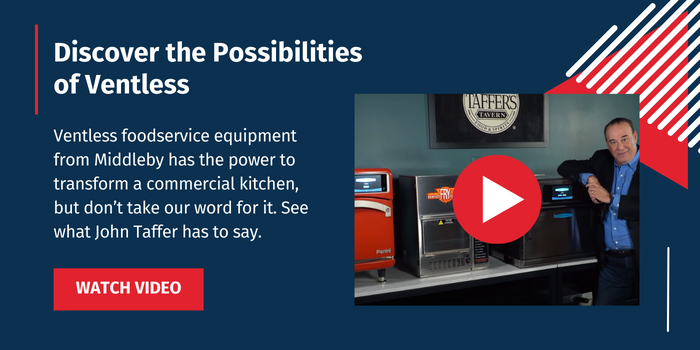Building the Ultimate Burger Bar with Ventless Foodservice Equipment

Few dishes hold the cultural significance and universal appeal of the hamburger. For operators, this is an opportunity to attract consumers with one of their all-time favorite dishes, and while burger production traditionally requires intricate ventilation in order to execute a burger menu, today, it’s possible to build a burger bar with ventless foodservice equipment.
Before we talk about burger production, though, let’s dig into the history. While many Americans can’t recall a time without hamburgers, it’s fascinating to note these iconic sandwiches only started gaining widespread popularity roughly a century ago. According to George Motz — a burger scholar, documentarian, and cookbook author specializing in hamburgers — hamburgers have become an American staple, deeply ingrained in our culture and culinary landscape. They’ve evolved from a simple sandwich to a gastronomic phenomenon, weaving their way into the fabric of our dining experiences.
For operators, this spells relevancy. According to Technomic, the average price of a specialty burger is $11.45. Forty-one percent of all U.S. restaurants feature burgers on their menus. And cheese, of course, is the top ingredient spot, also at 41 percent.
Burger Bars and Ventless Foodservice Equipment
When we think of burgers, we often think of the great-smelling exhaust that rises from a grill or a griddle. For foodservice operators, that exhaust is traditionally removed through ventilation systems that spread the great smells of hamburgers throughout the neighborhood or city. Preparation requires the removal of these byproducts, but not every operation can afford or accommodate the installation of expensive HVAC equipment. This is where ventless foodservice equipment steps in, offering a game-changing solution for operations without traditional ventilation.
The Benefits of Ventless Equipment for Burger Preparation
While traditional cooking methods are great, there can be some benefits for certain operators to use ventless equipment. Let’s review some of the important ones.
Cost-Effective Operation
Ventless foodservice equipment presents a significant cost-saving advantage as it eliminates the need for expensive hoods and ventilation systems. Traditional kitchen setups often require intricate HVAC installations, which can be a financial burden for many operations. With ventless solutions, businesses can redirect these savings towards enhancing other aspects of their burger program, contributing to a more streamlined and economically efficient operation.
Versatility with Electricity
Unlike traditional cooking methods that often rely on gas, ventless equipment can operate on electricity. This not only offers more flexibility in terms of kitchen layout and design but also allows for seamless integration into a variety of spaces. With electric equipment, operators can also mitigate any potential regulatory restrictions on the usage of gas.
Mobility for Profit Centers
One of the standout benefits of ventless equipment is its mobility. Without the constraint of running under a hood, these units can be easily moved to different areas of the operation. This transformative flexibility turns otherwise unused spaces, like the concourse of a stadium, into potential profit centers. Ventless cooking allows businesses to capitalize on unique locations, bringing the culinary experience closer to customers and maximizing revenue opportunities.
Energy Efficiency
Ventless foodservice equipment often boasts superior energy efficiency compared to traditional counterparts. These units are designed to minimize energy consumption, contributing not only to cost savings but also aligning with modern sustainability practices. By embracing ventless technology, burger operations can reduce their environmental impact while maintaining optimal cooking performance.
Portability and Adaptability
The portability of ventless equipment provides a distinctive advantage, especially for businesses with multiple properties. Unlike HVAC systems that are built into the infrastructure of a building, ventless solutions can be easily moved to other locations. This adaptability allows burger restaurants or chains to expand their reach without the constraints of fixed ventilation systems, making ventless cooking a practical choice for those seeking to grow and diversify their operations.
Don’t Forget the Sides
What’s a burger without the fries? Ultimately, consumer preferences for burgers don’t just involve the patty, bread, and toppings. Hamburger culture is also associated with side dishes, often fried, like French fries, onion rings, or even jalapeno poppers. If an operation is ventless, this means the production of these items must also be conducted with ventless equipment. In addition to ventless griddles and ventless ovens, ventless fryers are also part of a burger bar’s ventless foodservice equipment repertoire.
Go Ventless with Middleby
Building a better burger bar goes beyond the ingredients—it’s about embracing innovation. Ventless foodservice equipment not only revolutionizes burger preparation but unlocks a world of culinary possibilities. From diverse menus to adaptable locations, ventless solutions are the secret ingredient to crafting a burger bar that stands out in the crowded culinary landscape, and MIddleby can help.
See what bar expert Jon Taffer has to say about the power of going ventless in a burger bar:
Sources:
Topics
- Restaurants (93)
- Foodservice Industry Trends (57)
- Beverage (40)
- Ventless (37)
- Automation (30)
- See All Topics

